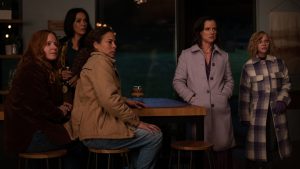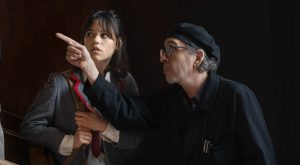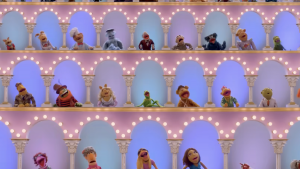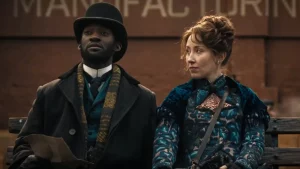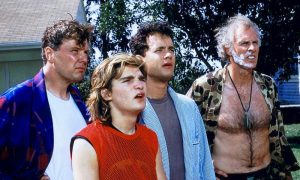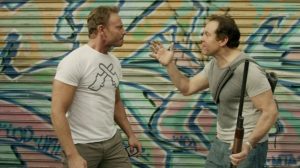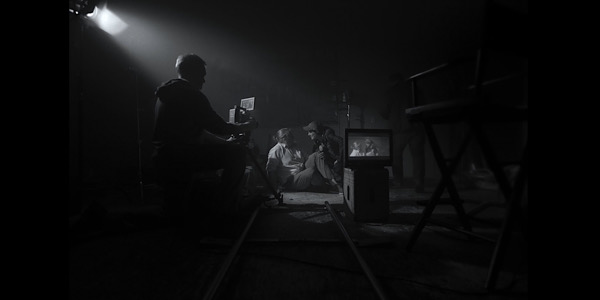
Taylor Olson is the star, writer, and director of the Slamdance film: Look at Me, a deeply personal, fictional autobiographical film that is bitingly funny, moving, and inherently: him.
I was able to sit down with the star for a casual chat about his journey from the film’s beginning to its fruition, our shared love for There Will Be Blood, and much more!
Kristy Strouse for Film Inquiry: Congratulations on the film. I really thought it was quite wonderful. It was very… I love the way that you took this project on. Now, this is considered a fictionalized autobiography, tell us a little bit about what that means exactly.
Taylor Olson: Yeah, absolutely. So, okay, so the way that I would explain what being a fictional autobiography is that all of the things that happen in the film are emotional truths, absolutely. So, there are things that, like, either directly happened, almost word for word in my life, or things that were close approximations. And the reason I wanted to call it a fictional autobiography is that there are things that are omitted from my life and then things that are kept, just to, like, make it an hour-and-a-half long movie and not, like, a miniseries, right? And these events span between when I was, like, 15 to, like, 27 when we started to shoot the movie. So, those things are just scattered about and then pulled together to try to fit into one cohesive story. That’s why I called it a fictional autobiography because although they all kind of happened at different points, they didn’t happen like that or in that order.
Yeah, that’s interesting. So how did you decide what to include and how to form this story?
Taylor Olson: Oh, that’s such a good question. I tried to set out letting the story almost tell me what it wanted to include, if that makes sense. So one of the rules I made for myself was that I wasn’t going to stick to a specific genre or anything like that. I was just going to leave it wide open and just whatever the moment was asking for, that’s what we would do. Eventually, you sort of cut that down so that you don’t have too many wacky things in the film. But it was always like, okay, what is this moment in the story asking for? How can we tell it in a way that is expressive and then just not censor ourselves? So that’s how that came about.
Yeah, I love that. So, this was a play first. How different was the play from the adaptation to film?
Taylor Olson: I’d say, like, story-wise, it’s 50-50. It’s brand new and 50 of it is the same. The play was a solo play, so it was just me telling my story direct to the audience, direct address, direct interaction. So the fictional autobiography piece of that was also true there. Like, it was like I was still making up things or creating new things. So, yeah, I’d say like 50% of the events are the same.
You know, in a lot of ways, being a writer, it can be cathartic to put your own experiences out there. Do you feel like that was part of the process as well, like in doing these two things?
Taylor Olson: Absolutely, yeah. Like, it’s not the intention, as, like, I’m sure you experienced it. You don’t, like, set out to be like, okay, I’m going to work through this thing. I’m not making this my therapist. It just happens to me. It just happens to do it. Like, I think probably in any way, whether it’s autobiography or just personal or whatever, all art that you create hopefully is healing to you. And so I definitely found that to be the case here and that, like, it was interesting because it brought up really, like, sort of thoughtful conversations amongst the crew as we were shooting that, like, we’d be in the middle of a scene and we’d be like, they’d be like, why are we doing this now? And what does this matter? And the DOP would be asking that. And so we were able to, like, have this almost catharsis together because we created a set where essentially the best idea wins. So if, like, the grip has the best idea, then we put that into the movie. So very collaborative.
Yeah, I can see that. I can see that for the crew. I can see that for viewers. A lot of people watching this and being, you know, finding things relatable and finding their own catharsis in watching it. And I hope that that’s been a response that you’ve gotten.
Taylor Olson: Yeah. I’ve been surprised every time that someone watches it and has that. It’s been a really lovely surprise. And last night we had the premiere and it was definitely like that. People who maybe haven’t experienced an eating disorder themselves or haven’t even been close to someone who has, it’s the thing that has surprised me has been that, like, everyone can kind of relate to it in some way because of the way that, like, society is structured and the way we think about people’s bodies and the way that we judge them. The pressure. Or uphold them or whatever means that, like, we’re all constantly thinking about it. Even the most confident, secure person has these insecurities. And so, yeah, it’s been interesting to sort of see that in other people.
Yeah. That’s great. And so the premiere, how did that go? How was that? What was that like?
Taylor Olson: It was wild. It was really fun. Yeah. You know, this is like a bucket list thing for me. Yeah. It’s like. It’s pretty cool. Yeah, like a lot of, like, filmmakers that I love and admire have been here, including, like, Canadian filmmakers. Like, Matt Johnson had The Dirties and he just did Blackberry this year. I love his work and so it’s, yeah. Blackberry, yeah. Yeah, yeah. It’s a good movie. And so, yeah, it was really special. And it was really special just to connect in the Q&A with people. And, like, it felt like we were able to just have this conversation about this thing that I feel like in my day-to-day life we don’t talk about, especially amongst, like, you don’t see men talking about this. And it was really cool to have, like, a lot of young men specifically come up after the Q&A and talk with us and be like, yeah, I get that. And it was like, right, okay, like, these conversations have only experienced either after doing the play or after the film. Right. So that was kind of cool, yeah.
I think it takes immense courage and vulnerability to put yourself out here like this, especially, you know, starring, doing all the work, it seems like, a lot of the hats. And I like your hat, by the way.
Taylor Olson: Oh, thanks.
Do you have any kind of advice to people that are also looking to tell their stories? Did it take some time to kind of get that courage to put yourself out there like that?
Taylor Olson: I mean, to go, like, the play was first, and I almost wrote the grant kind of on a, not a dare, but almost a dare from my partner who was like, this is this thing that you’ve dealt with, and, like, I know about it, and we’ve talked about it, but, like, no one talks about it, so, like, you should go talk about it. And I was like, I’ll write a grant, and I won’t get it, and it’ll be fine because at least I tried, and then somehow we got the grant, and I was like, oh, shoot.
source: Slamdance Film Festival
That’s amazing. What was it?
Taylor Olson: It was, like, an arts grant for the province to put the show up, and then immediately, like, you say, like, did it take courage? It’s like, yeah, because I knew about the grant for three months, and the date of putting the show up was, like, a week and a half away, and I hadn’t written it because I was so afraid of it. So you had to get it. And then I had to write it, and then I had, like, four days to rehearse it and then just do it.
Oh, wow.
Taylor Olson: And it was one of those things where it was, like, as soon as, so I was put in this corner. Lik e, I wasn’t brave enough at that point to do it myself. Yeah. I was, like, I was put in a corner, and I had to. I was, like, either you give the money back, which you’ve already spent, like, a quarter of it, or, you know, or you just do it.
No one puts baby in a corner.
Taylor Olson: Exactly. Yeah, exactly. And so I think coming into the film, I had this false idea that I understood what it was going to be, and I had signed up for the mission and that, like, I knew I had to be vulnerable, and that’s fine. I’m now comfortable with it. And immediately I was sort of thrown at the idea that I was, like, oh, like, this is just as hard as I thought it was, and vulnerability is hard. But the thing I would say to anyone else who wants to tell their story is that you might have this, like, sitting feeling in the back of your head that you’re, like, no one cares. This doesn’t matter. Like, it’s just me. Like, I’m nobody. I’m not interesting or important. It doesn’t matter. So why would I tell my story? And the thing I would say is that, like, the thing that is beautiful about what we do in telling our stories is that, like, we’re all so unique and specific that, like, your story does matter. Just try to remind yourself that.
No, I love that.
Taylor Olson: And Surround yourself with people who, like, will say that to you.
Yeah. Because you won’t believe it for a long time.
Taylor Olson: Yeah, you know, I mean, I’ve always been someone that’s been super anxiety a lot of things. And I feel like the best things that have ever happened are the things that I feared and I just took them on.
Yeah. Because I wanted it, but I knew I was also scared and, like, going for it. So I feel like that’s probably similar to the way that your mindset was.
Taylor Olson: That’s it. Yeah. No, I love that. And congratulations on the brand and everything. That’s got to be.
Is this your first festival?
Taylor Olson: No, But my first festival I’ve been able to attend in person because my first feature was released during COVID. So it was all virtual or it was happening in person and I couldn’t travel. Right. So this is, like, my first feature I never saw on the big screen. So last night was the first time I ever saw, like, my feature work on the big screen, which was kind of cool.
Yeah, it’s very, very cool. No, I noticed that you do a lot of quotes, movie quotes.
Taylor Olson: Yeah.
That’s totally me too. That’s why I had to throw in that dirty dancing. No, I do it all the time and sometimes I get looks .And there was, like, a couple times in the movie where you do it and people don’t necessarily, like, you have to explain it and then it’s like, never mind.
Taylor Olson: Yeah. I do that all the time.
Yeah, that’s awesome. So you obviously are just a big movie fan.
Taylor Olson: Yeah, I’m, like, maybe obsessed. Yeah. Well, you know. And I don’t know, I’ve always thought that, like, I think there’s something that happens that’s really funny when, like, a quote becomes really famous and then, like, the quote becomes a parody of itself.
Right, like “I could have been a contender.”
Taylor Olson: Yeah, exactly. Or, like, things that, like, yeah, exactly. Like that one specifically. So then I kind of like the idea of playing with these things that are, like, famous quotes that are almost parodies of themselves and then you try to parody it and then it’s like, how many hats are on a hat? And I kind of like that, yeah.
That’s awesome. So do you have any inspirations or anything you drew from as far as, like, favorite films or films that you looked at when making this movie?
Taylor Olson: Totally. Yeah, I’m a sex addict. It was a movie, I mispronounced his name, but his first name is Kevessa, I think Kevessa Hadid. And he made a movie where he plays himself as a sex addict and it’s his journey and I was, like, blown away. And I was like, oh, like, maybe that’s the format I could use for this. And then another one is on eighth grade.
Oh, yeah, a great film.
Taylor Olson: Because she’s, I love that movie, one of my favorites. Because she’s so, like, insecure and, like, when I watched it, I was like, oh, my God, that was me in eighth grade. And so I was like, oh, like, maybe this is, like, the adult version of that. So that, and then in terms of, like, visual, some of the visual things, like, we pulled a lot from, like, some of, like, the rigidity of, like, Wes Anderson’s work where, like, it’s, like, a lot of 90-degree angles. Yes. And, like, helps, like, match the character’s awkwardness. So that, and then the black and white, like, we wanted to sort of get closer to the black and white from, like, Frances Ha, which I love the black and white in that. It’s just very, like, grounded. I can see that. Yeah. No, those are all great.
I know this is, like, the worst question to ask a movie fan, but do you have a favorite movie or ten?
Taylor Olson: I do. I do have a favorite. It’s, like, usually people are like, I can never name a favorite. But my favorite movie is There Will Be Blood.
Oh, gosh, such a good movie.
Taylor Olson: It’s the movie that made me want to make movies and, like, act in movies. I love Paul Thomas Anderson.
Me too. And There Will Be Blood is just a masterpiece. Daniel Day-Lewis is just insanely good.
Taylor Olson: Yeah, that’s amazing. But that would be one. And then, like, Eighth grade would definitely be one. I love American Honey. So, like, those would be some of them, yeah.
What are you hoping, kind of, audiences take away from your film?
Taylor Olson: You know, so, like, the reason that, you know, as I was trying to find a purpose for telling this story, I kept thinking about, like, the teenage version of myself who was dealing with this. It was just, like, felt like there was probably no other, like, young, you know, boy dealing with this, essentially. And so, really, the movie’s kind of made for, like, those kind of kids who are dealing with that. It’s almost like that version of myself is what the movie’s made for. And so, hopefully, it just helps people feel, it’s kind of truthful, like, feel seen and, like, not so alone.
Yeah, I love that.
Taylor Olson: Like, I think, like, that’s the, for me, that’s why I would continue to make movies. It’s just, like, it helps you feel, like, in community with people, even if you never meet them, which is kind of cool. And, like, yeah, just not so alone, feel seen. And then, also, for people who, like, maybe don’t have any insight into an eating disorder or an addiction, which is essentially what it is. You know, hopefully, it just helps them understand, like, what it’s like and see the people behind the eating disorder, too.
Are you working on anything now?
Taylor Olson: Yeah, I just shot two days of my next feature.
Wow, that’s fast.
Taylor Olson: So, we shot some stuff to capture winter. And then, the rest of it’s going to be shot only in one block this time in the spring.
And that’s where you’re from shooting? You’re shooting?
Taylor Olson: Yeah, shooting in St. John, which is a province right beside Nova Scotia. So, yeah, it’s a story told in two timelines. And they kind of go forward and backwards. So, we capture, like, many seasons.
And so, we needed to shoot, like, a little bit of, like, true, like, minus 12 winter. Yeah, nothing like this. This is warm. This is like summer. Yeah, so we shot a little bit of that. So, that’s, yeah, we’re working on that now. And, yeah, we made this movie on, like, in U.S. dollars, it would be like $65,000. And that one we’re making it with a bit more. It’s, like, $1.3 million. So, it’s, like, nice to have a real budget.
That’s amazing. Well, congratulations!
Taylor Olson: Thanks!
You did a great job. Enjoy it!
We want to thank Taylor Olson for taking the time to speak with us!
Does content like this matter to you?
Become a Member and support film journalism. Unlock access to all of Film Inquiry`s great articles. Join a community of like-minded readers who are passionate about cinema – get access to our private members Network, give back to independent filmmakers, and more.
Join now!



